Text and Photos by Danielle Lachana
Kea, as it is officially known, or more often 'Tzia' as it is referred to by the Greeks, is perhaps one of Greece's best kept 'secrets'. At only one hour's distance from Athens by ferry from the port of Lavrio you can be in a totally different environment, far from the busy and bustling capital of Greece.
Kea is the closest, and probably least-publicized, of the Cycladic islands, and as such has remained basically immune to tourism. This is not to say that it does not attract the crowds however, since many Athenians have a holiday home there where they spend their summers. Consequently, Autumn is an ideal time to visit for those who love nature, and relaxation. While, at this time of year, you may not venture to swim in the crystal clear waters of one Kea's numerous beaches, such as Koundouros,

the weather will surely be fine enough for walking along the sand or on the waterfront at the picturesque port of Vourkari known for its fish taverns.

Otherwise you can trek more inland: the adventurous can hike to Ancient Karthaia, with its 6th century temples of Athena and Apollo (a round trip of up to 2 hours) whereas more readily accessible are many shorter, and easy trails through nature, in cool valleys refreshed by mountain springs, passing abandoned watermills, or in the mountainous interior, with its sweeping views of the verdant island. A highlight will surely be the 15-minute walk along a paved footpath from the central town of Ioulida (see below) which will take you to what has become the symbol and protector of the island - a huge (6 m by 3 m) enigmatic smiling lion carved into the rock. ''Lionda'', as he is known locally, dates back to the 6th C BC and is said to resemble the lion that according to mythology heroically chased away the nymphs who had started killing the women on the island.
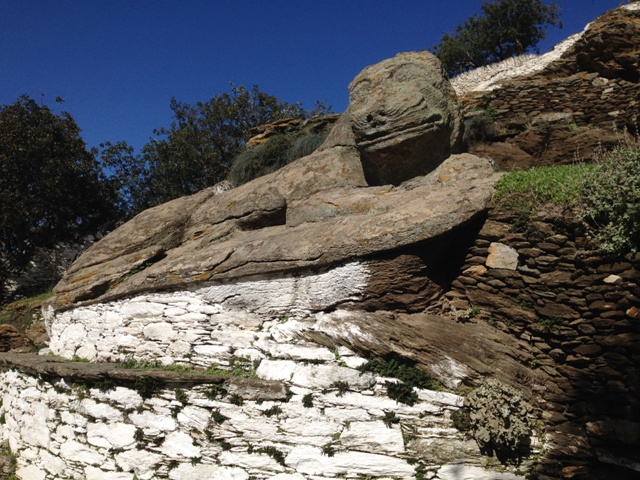
Daily life in Kea centres not only around the main port of Korissia - where a few cafeterias and tavernas welcome the ferry arrivals, but also, and especially outside the summer season, in amphitheatrically-built Ioulida (or Ioulis), 5 kilometres up the hill from Korissia and which is more often simply referred to as 'Chora', meaning 'town'.
Chora is particularly interesting architecturally since while it does present many of the cubic white-washed buildings typical of the Cycladic islands it also incorporates a lot of stone elements

and, most attractively, also earthy, pink and russet Venetian tones.

In addition one must not forget the presence of some neoclassical buildings such as the old town hall, designed by German architect Ernst Ziller, and the former school, now housing the main building of the new town hall.

View of Chora with former school building to the right.
In Chora you can lose yourself in the maze of narrow winding streets, designed to foil pirates and invaders in the past, and discover elements of the old medieval castle in the ''Kastro'' section with its remains of both ancient fortifications and of the Venetian wall.
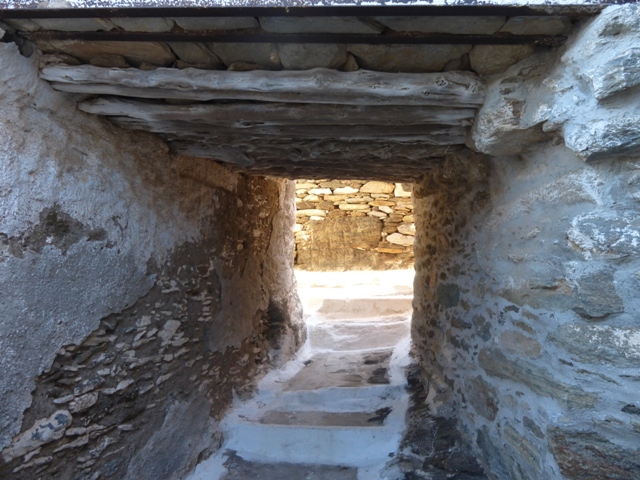
A highlight of Chora is the fairly small, but excellent, archaeological museum housing finds from the 7th to 2nd C BC, including those from Karthaia, but also an amazing exhibition of the 'Kores',
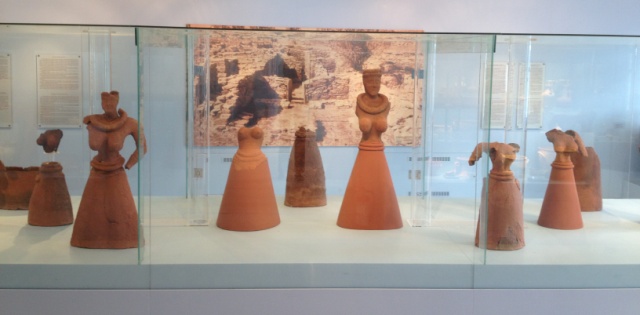
female clay idols of impressive height from the Bronze-age settlement of Agia Irini by the port of Vourkari - the site is fenced off but you can get a reasonable view from outside.
Also worth a visit is the ''Museum of Agriculture Folklore and Cultural Heritage'' in Milopotamos. It provides an insight into the traditional agricultural and village life of the island and is housed in an old wood and stone former inn dating back to 1845. Nearby is a small open-air kind of 'museum' with machinery and equipment from the old enamel factory, once the largest in the Mediterranean, and which formerly boosted the island's economy. Its 45-metre chimney still stands proud above the crumbling buildings and the fields of turkeys and hens.

Like many other Cycladic islands, Kea has its fair share of monasteries and churches - from the imposing 18th C monastery of Kastriani with its panoramic views of the coast to the tiny church of Agios Thanassis,

but one of its most striking features remains its agricultural richness and hence its authentic cuisine.
Kea is much more fertile than many of its neighbours so it comes as no surprise that food is good, centred around the fresh local produce. Many dishes are based on the abundant pork meat such as lotza (cured thinly sliced pork), tsigara (pork with fat), homemade sausages, (especially good are the smoked ones), and above all, paspalas made from pork, eggs and tomato, which is eaten at any time of day or night (GR Reporter recipe at http://www.grreporter.info/en/paspalas_pork_tomato_and_eggs/13676).
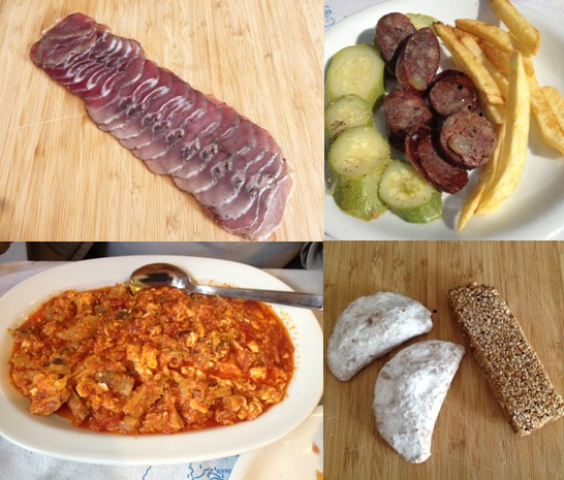
These dishes are especially good when accompanied by a glass of the local dry red wine, 'Mavroudi'. For those with a sweet tooth there is the excellent local honey, which also features in the 'pasteli' - sesame seed bars, or the wonderful Tziotika Kaltsounia, an icing sugar-dusted crescent-shaped pastry filled with dried fruits and the ubiquitous almonds. Or, why not try something a little different - biscuits made with the most unusual of the local specialities - acorns!
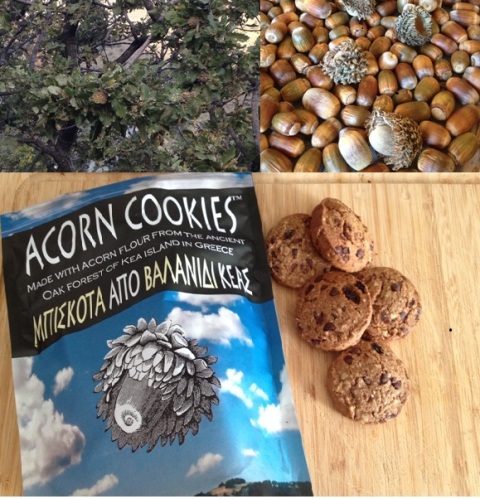
The island boasts the only oak forest of the Cycladic islands - present since medieval times. Its acorns have a particularly large cup, which was used in former times for making dye. Today the acorn is being ''re-exploited'' in Kea - you can volunteer to go acorn-picking in October and stay on a farm! Acorns are removed from the trees by bashing with sticks - then ground into flour for use in the biscuits.The local acorn festival also takes place around this time.

Aside from the acorn festival, Autumn night-life is low-key, centred mainly around a few tavernas and bars with their warm, rather than 'electric' atmosphere.
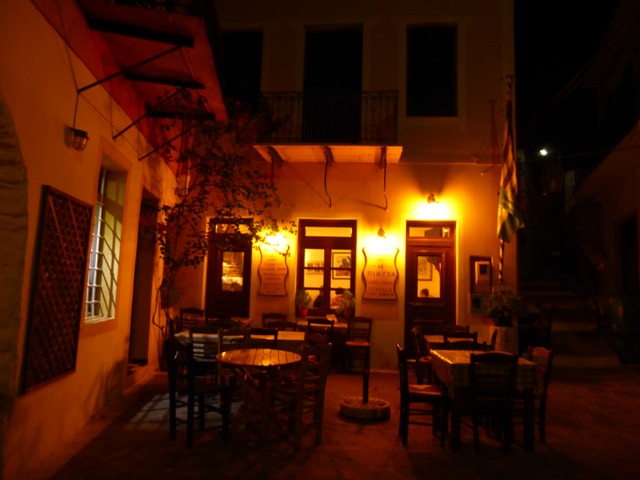
Nevertheless, people will greet you wherever you are, politely, helpfully and without any curiosity - as if you are just one of the locals going about your daily life. And it is not just the people who are friendly - along your way you will surely meet some stray sheep or goats (even inside the towns) a couple of lone cows or even donkeys...

All in all, Kea is a truly 'Greek', Greek island, unspoilt by the ravages of time or tourism, open and welcoming as the perfect destination for an Autumn weekend get-away - a weekend which will surely leave you wanting to return again, perhaps in the summer to sample also Kea's beaches and its varied artistic events and festivals such as those of wine, honey and... fairy tales! See you there!